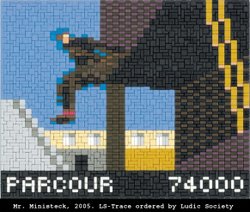Margarete Jahrmann / Max Moswitzer
Both * 1968 in Vienna, Austria, live and work in Zurich, Switzerland.
The two artists co-founded Ludic Society (2006), introduced Game Fashion (2007), urban games (2006), and Ludic ‘Pataboardartifacts (Arco Madrid06). Both lecture since 2006 Game Design at University of Arts Zurich and Angewandte Wien; 2004/2005 lecturers thematic projects Piet Zwart Institute Rotterdam. Awards: 2003 Prix Ars Electronica03, interactive arts distinction. 2004 software art award transmediale Berlin. Moswitzer 2008: Ars Electronica Second Life Architecture Award Jahrmann Moswitzer showed at 2007/08 (Plymouth, UK (Social Hacking commissioned by kurator.org), 2008 Kunsthalle Box Kunst und Politik der Spiele, Japan (Tokyo DIGRA), Brasil (File Rio), Spain (Laboral) and Netherlands (V2_DEAF). Exhibitions 2009: Jahrmann: Kunstmuseum Aros, Aarhus, Denmark; Enter Action Edith Russ Haus Oldenburg; Wearable Technologies; Tales of Play, Lima, Peru. Moswitzer: Centre Pompidou, Paris; Tribute to Chris Marker.
http://www.ludic-society.net
Parcour Ready Played
Video-loop, 2006
Banlieues, die Vororte von Frankreich und auch anderswo sind nicht gemacht, um darin zu leben, sondern um darin zu spielen, sei es mit Autos, Fahrrädern, oder auch mit dem eigenen Körper – ganz so als wäre man selbst Spielfigur. Die französischen Le Parcour-SpielerInnen springen waghalsig wie Super Mario über Mauern. Die Praxis dieser Spielgemeinschaft fordert die Stadt zurück; es handelt sich hierbei um die spielerische Wieder-Aneignung des urbanen Raums. Als wir im November 2005 diese These aufstellten ereigneten sich gerade die ersten massiven Ausschreitungen in den Straßen von Paris. Autos wurden verbrannt und im direkten Eingriff in den öffentlichen Raum fand die unterdrückte Jugend ihre Stimme wieder. Die Parcour-Kultur stellt eine subtilere Form des Widerstands dar, die jedoch die selbe Wirkungsmacht birgt da auch sie mit der Absurdität des Lebens spielt, als hätte die SpielerIn nichts mehr zu verlieren. Dies ist die Realität unserer Spielgesellschaften, eine Praxis des Spiels die ein brauchbarer Bestandteil der Spiel-Toolbox für politische Tatkraft ist. Die Entscheidung aus dem Material kein Spiel zu machen, sondern stattdessen einen interpassiven Video-Loop zu schneiden ist Resultat einer taktischen Überlegung, das Individuum soll eine unerträgliche Passivität fühlen. Der endgültige Schnitt des Spielvideos, der einem Videospiel im Schnelldurchlauf ähnelt, ist der Tribut den wir der Gesellschaft des Spektakels zollen. Die
Entscheidung den Clip hochauflösend aufzubereiten war eine rein ästhetische. Sie verbindet den vielgeliebten Retro-Stil und dessen emotionale Warmherzigkeit mit dem Publikum der Videospielgeneration, die nun – erwachsen geworden – ebenfalls Kunst genießt. Der Spielstand, wie ein Spielzeugbalken am unteren Rand des Clips, stellt einen ähnlichen Kunstgriff dar, um den vergleichenden Blick hervorzurufen, der die Spiel-Medialität von Realität erkennt und das Spiel selbst als befreiendes Verhalten ansieht. Praxen wie diese nennen wir „Real Playing“ da die Spielzone auf die gesamte Stadt ausgedehnt wird. „Real Players“ haben eine wichtige Funktion in der Rekonstruktion alltagsweltlicher Spielregeln.
Banlieues, the suburbs in France and elsewhere, are not built for living but for playing, either with cars or bikes or with your own body, as if you were a game character. The French Le Parcour players jump life-risking like Super Mario over walls. Such a Ludic Society practice reclaims the city, is a re-appropriation of the urban space by play. When we observed this thesis in November 2005 in Paris the first massive riots started on the streets, cars were burned and the suppressed youth was getting a voice by urban intervention. The parcour culture shows the more subtle form of resistance, but puts it on the same level of efficacy, playing with the absurdity of life, like a game, in which the player has nothing to loose. This is a reality of our Ludic Societies, a practice of play viable as part of the Ludic toolbox for political agency. The decision to make no game out of this footage, but to cut an interpassive video-loop, was a tactic, to make the individual feel unbearably passive. The final cut of the game-video like a speed-run of a video-game, is a tribute to the society of the spectacle. The editing of the clip in high pixelation was a simple aesthetic decision, combining the beloved retro-style with its expected emotional affection to joystick nations audiences, who are grown up now to visit arts. The games score, like a toy-bar on the bottom of the clip was a similar artifice, to evoke the comparative view on reality as game-medium and play as deliberating behavior. Such practices we call “Real Playing”, which extend game zones into cities. Real Players incorporate a crucial role in the reconstruction of the rules of play of everyday life.


